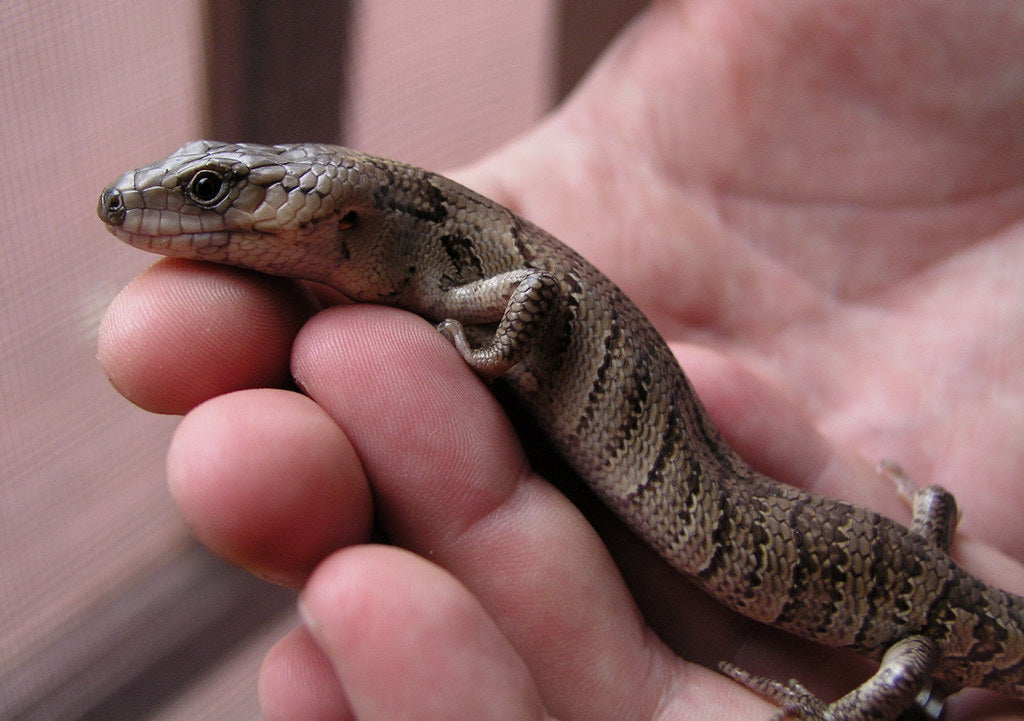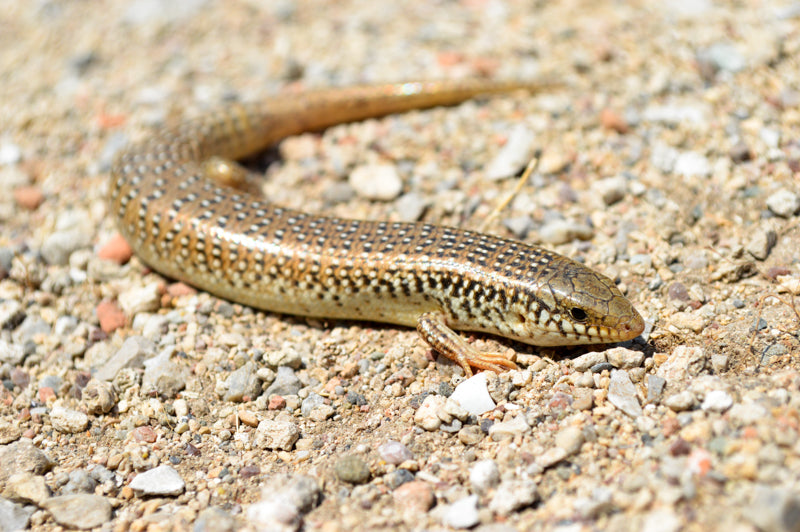Pink-tongued skinks (Cyclodomorphus gerrardii) are medium-sized, nocturnal, semi-arboreal lizards native to Australia, specifically New South Wales and Queensland. They prefer the sub-tropical sclerophyll forest, rain forest, and moist woodlands for habitat.
Pink-tongued skinks are 15-18” long lizard with a blunt triangular head, slender elongated body, short limbs, strong toes, and smooth scales. Coloring is generally light brown to silver-gray with dark bands from neck to tail, although patternless individuals are known.
Despite not being common in the pet trade, pink-tongued skinks can make surprisingly good pets. However, they do have specific dietary needs, which makes them intermediate-level pet reptiles. With good care, they can live up to 20 years!
How much space do pink-tongued skinks need?
A single pink-tongued skink should be housed in no smaller than a 36”L x 18”W x 36”H enclosure. Many sources recommend smaller, but these recommendations are based on outdated standards and should not be used. Pink-tongued skinks are good-sized lizards and need plenty of room to climb, so if you can provide a larger enclosure, do it!
Cohabitation (keeping multiple pink-tongued skinks in the same terrarium) is not recommended, and may result in fighting and severe injuries if attempted.
Do pink-tongued skinks need UVB?
Although pink-tongued skinks are nocturnal, they are known to do best when UVB lighting is provided. Aside from helping provide a day/night cycle and supplying an infinite supply of vitamin D, UVB is also good for your skink’s overall health. So, it’s best to provide appropriate UVB lighting as part of its enclosure. The best UVB bulbs for pink-tongued skinks are:
- Zoo Med Reptisun T5 HO 5.0, 22”
- Arcadia Forest 6%, 22”
If the UVB is mounted over mesh, place the basking area so the skink’s back will be 6-9” below the lamp. If the lamp is inside the enclosure, this distance needs to be increased to 11-12” to compensate. The UVB bulb should be housed in a reflective fixture by Arcadia or Vivarium Electronics, and placed on the basking side along with the heat lamp.
Note: UVB is blocked by glass and plastic, so you can’t give your skink UVB by placing its terrarium in front of an open window. Also make sure that the fixture your UVB bulb is in does not have a clear plastic bulb cover.
Lights should be on for 13 hours/day during summer and 11 hours/day during winter. This simulates natural seasonal changes in day length and encourages healthier hormonal rhythms.
What basking temperatures do pink-tongued skinks need?
Pink-tongued skinks prefer the following temperature gradient:
- Basking area: 90-95°F
- Cool end: 75-80°F
- Nighttime: >68°F
Measure your basking temperature with a digital probe thermometer with the probe placed on the basking surface (preferably a branch or ledge). Another thermometer should be placed on the cool end so you can get a good idea of your temperature gradient at a glance.
Provide heat for your skink by imitating the sun with at least two halogen heat lamps clustered on one side of the enclosure. Do not use ceramic heat emitters (CHEs), heat mats, red bulbs, or blue bulbs, as these are not as effective. Heating should be turned off at night.
What humidity levels do pink-tongued skinks need?
Pink-tongued skinks are a subtropical species, so they need subtropical humidity levels. Humidity should be more or less kept in the range of 70-90% at all times to keep your pet well hydrated. You can measure this with a digital probe hygrometer with the probe in the middle of the terrarium.
To increase local humidity, mist the enclosure at least once a day with a pressure sprayer. If you live in a particularly dry climate, installing a fogger regulated by a hydrostat for nighttime is a good idea.
What substrate is good for pink-tongued skinks?
Substrate covers the floor of your skink’s terrarium and helps make the enclosure more attractive, but it also helps maintain higher humidity levels and provides something for your skink to dig in.
It’s ideal to use a substrate that imitates the “substrate” that the reptile naturally lives on in the wild. For pink tongue skinks, that means it should resemble soil. It should have small particles, hold moisture well, and be loose enough to dig in.
We recommend the following substrates for pink-tongued skinks:
- Zoo Med Eco Earth
- Zoo Med ReptiSoil
- Exo Terra Plantation Soil
Layering clean, chemical-free leaf litter on top of the substrate can help with humidity as well as adding enrichment value.
Substrate should be at least 4” deep and completely replaced every 3-4 months. Remove poop and urates daily, along with contaminated substrate.
What décor can you use in a pink-tongued skink terrarium?
One of the best ways you can help your pink-tongued skink be happy in its enclosure is to fill it with things for it to use and interact with. Here are some ideas:
- climbing branches
- cork hollows
- ledges
- ground hides
- live or artificial foliage
At minimum you will need at least two hides on the ground, a sturdy branch for climbing and basking, and some foliage for cover, but it’s best practice to do more than the minimum.
What do pink-tongued skinks eat?
Pink-tongued skinks are specialist snail-eaters, so it’s important that the majority of their diet is snails. These snails should not be collected from your backyard or from the wild, as they may carry dangerous parasites or pesticide residues. Instead, use canned snails or frozen snails from your local asian foods store. It is ideal, however, to breed your own golden apple snails or garden snails as feeders. Feeder insects such as mealworms, earthworms, silkworms, or hornworms may be offered, but they may be rejected.
Feed juveniles daily, and feed adults every other day. The average pink-tongued skink will take 4-10 snails, depending on the size of the snail. Fruit such as mango can be offered as an occasional treat.
Supplements
You will also need calcium and vitamin supplements to prevent your skink from developing a deficiency - this is especially the case for shelled snails. We recommend Repashy Calcium Plus LoD, dusted on all feeders before offering.
Water
Of course, don’t forget a large water bowl for your skink to drink from! Change the water daily and scrub the bowl with a reptile-safe disinfectant weekly, or whenever it becomes soiled.
Do pink tongue skinks like to be handled?
Few reptiles actually “like” to be held, but pink tongue skinks tend to tolerate it well, especially individuals that were bred in captivity. Don’t grab the lizard from above — instead, approach from the side and scoop from below. Do not force interactions — instead, let the skink come to you.
When holding your pink-tongued skink, support as much of its body as possible, especially its feet. Let it climb freely on you. Start with very short handling sessions in the beginning, then gradually make them longer as your pet becomes more accustomed to you.
*This care sheet contains only very basic information. Although it’s a good introduction, please do further research with high-quality sources to obtain additional information on caring for this species.
"Pinkie" by petrichor is licensed under CC BY-NC-ND 2.0




Leave a comment
This site is protected by hCaptcha and the hCaptcha Privacy Policy and Terms of Service apply.